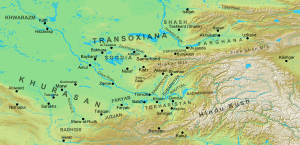
Back وقعة خاريستان Arabic খারিস্তানের যুদ্ধ Bengali/Bangla نبرد خارستان Persian Battaglia di Kharistan Italian Batalha de Caristão Portuguese Битва при Харистане Russian
| Battle of Kharistan | |||||||
|---|---|---|---|---|---|---|---|
| Part of the Muslim conquest of Transoxiana | |||||||
 Map of Khurasan and Transoxiana in the 8th century | |||||||
| |||||||
| Belligerents | |||||||
|
Umayyad Caliphate Principality of Juzjan |
Türgesh Khaganate Sogdian princes of Transoxiana | ||||||
| Commanders and leaders | |||||||
| Asad ibn Abdallah al-Qasri |
Suluk al-Harith ibn Surayj | ||||||
| Strength | |||||||
| c. 7,000 men | c. 4,000 men | ||||||
Location within Afghanistan | |||||||
The Battle of Kharistan was fought between the forces of the Umayyad Caliphate and the Turkic Türgesh in December 737 near the town of Kharistan in Juzjan, eastern Khurasan (modern northern Afghanistan). The Umayyads, under the governor of Khurasan, Asad ibn Abdallah al-Qasri, managed to surprise and defeat the Türgesh khagan, Suluk, and his ally, the Arab renegade al-Harith ibn Surayj.
The Arab armies of the Umayyad Caliphate had conquered most of Transoxiana in the early years of the 8th century, as part of the Muslim conquests. From c. 720, Umayyad rule was increasingly challenged by attacks from the Turkic Türgesh nomads from the north, and revolts of the native princes of Transoxiana. After a major defeat in the Battle of the Defile in 731, the Umayyads lost control over most of Transoxiana, while in 734–736 al-Harith ibn Surayj led a major rebellion against the caliphate's governors in Khurasan itself. The appointment of the veteran Asad ibn Abdallah al-Qasri brought about the defeat of Ibn Surayj, but in 737 Asad's attempt to restore Umayyad control over Khuttal ended in a debacle when the Türgesh attacked his army. Although Asad managed to save most of his force, he suffered heavy losses, and lost most of his army's baggage train and its escort in the Battle of the Baggage on 30 September. Asad withdrew to Balkh, leaving the field to the Türgesh.
While the Arab army demobilized and returned to their homes for winter, the Türgesh ruler Suluk, now advised by Ibn Surayj, launched an invasion of Lower Tokharistan. This left Asad with far fewer men to confront the Türgesh invasion, but when the Türgesh ruler dispersed his army to raid and gather forage, Asad seized the opportunity to confront him. With 7,000 men he surprised Suluk, who had only about 4,000 troops with him, and defeated him near Kharistan. The Türgesh ruler and Ibn Surayj managed to flee, but his camp fell into Arab hands, and most of the roaming bands of the Türgesh army were destroyed. This unexpected victory shored up the threatened Umayyad position in Khurasan, while diminishing the prestige of Suluk, who fell victim to inter-Türgesh rivalries in early 738. Asad's successor Nasr ibn Sayyar was able to use the collapse of Türgesh power, and by c. 743 had restored the Arab position in Transoxiana almost to what it had been before the Türgesh intervention.
© MMXXIII Rich X Search. We shall prevail. All rights reserved. Rich X Search
